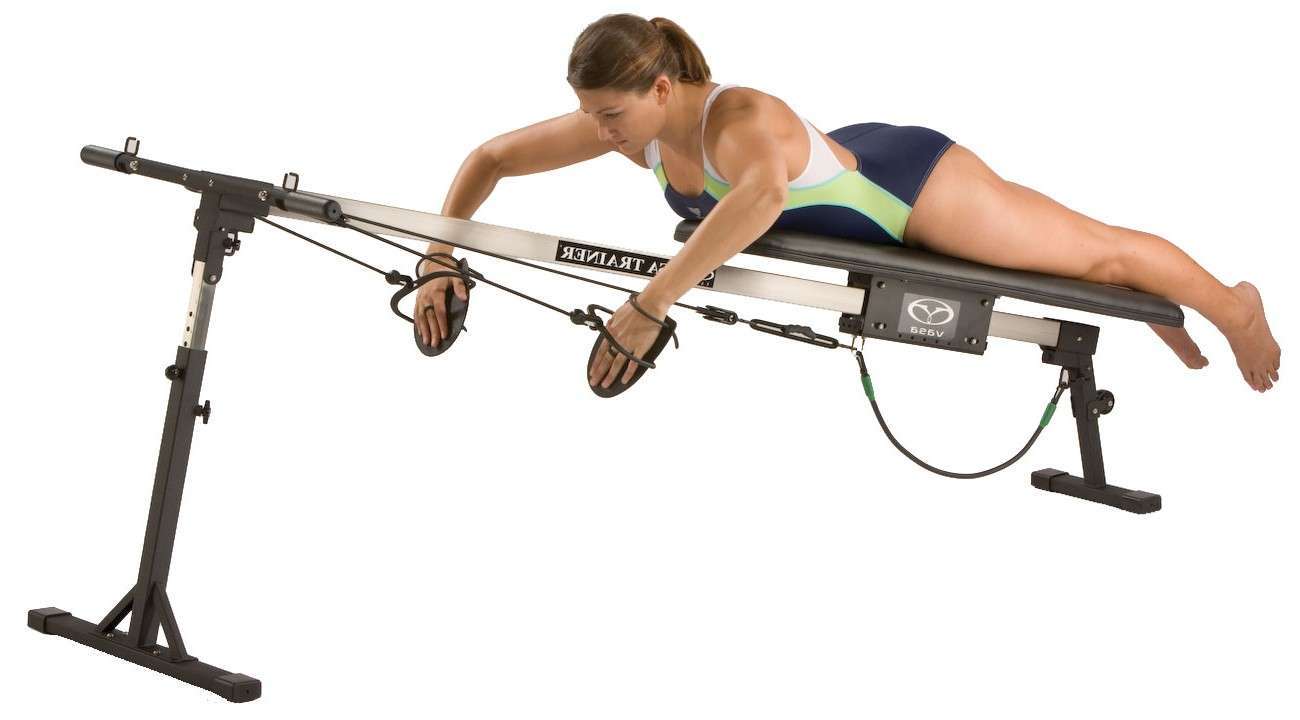
Coach Richard Shoulberg presents suggested workouts for all swim strokes for distance swimmers, middle distance swimmers, and sprinters on the Vasa Trainer. These pool-deck workouts focus on stroke technique, negative resistance (eccentric motion) and recovery motions as the Vasa Trainer angle is gradually raised to increase difficulty.
In order to get the maximum benefits from the Vasa Trainer, one must use proper technique. I stress that one of the many real values of the Vasa Trainer is that one is able to get the hands underneath the body as he or she moves up the inclined monorail. I cannot do this on my home-made machines. I have the Vasa Trainers right on the pool deck so that while I am coaching swimmers I can still check for proper technique being used by those working on the Vasa Trainers. I often will use a pace clock for work on the Vasa Trainers, much like sets in the pool.
Twenty percent of the training with the Vasa Trainer is done as negative resistance (this is resisting the return of the swim bench as you move back down the monorail) and this is done for Butterfly, Backstroke (using both arms at once), Breaststroke with pull straps crisscrossed under monorail, or recovery work. It is important when doing strength work on the Vasa Trainer that the swimmer return back down the monorail slowly. I recommend that my swimmers use a cadence – up on 1 count, return on 3 – 5 count.
Some of my sprinters do thirty five percent of their Vasa Trainer work as recovery motions (see “PART 4 – Section 4.3 – Stroke Illustrations”). The rest of the training is done in the strokes of choice, as outlined below.
Example Workouts
Warm-Up Before we begin any strength training with the Vasa Trainer, we always warm up with light work using light medicine balls or 5 minutes of “mirror swimming”. (Mirror swimming is  simulating the swim strokes while you look into a mirror, concentrating on executing perfect technique.)
simulating the swim strokes while you look into a mirror, concentrating on executing perfect technique.)
Monday, Wednesday, Friday
Strokes: Butterfly, backstroke (both arms at one time), breaststroke (crisscross the pull straps under the monorail), freestyle, or recovery stroke. All swimmers: Start with monorail at lowest angle – call this a “1” setting.
1) Do 12 pulls, with slow, negative returns (up on 1 count, back on 3-5 count). Rest 25 seconds.
2) Do 12 pulls at the next setting, 1 pin hole up, increasing angle of monorail. Rest 25 seconds.
3) Repeat this sequence, increasing 1 pin hole setting for each set, until you cannot do 12 pulls.
Recovery Stroke: (works best for butterfly, but can be used effectively for all strokes) Start with the monorail at lowest angle or “1” setting. For weaker swimmers you may need to elevate the rear stanchion of the Vasa until the monorail is level with the floor by placing kick boards or stable boards under the rubber feet.
Repeat the sequence above, doing 12 reps per set until you are fatigued.
Tuesday, Thursday
Distance Swimmers: Steady work for 16 minutes at one setting in chosen stroke. Increase incline setting for monorail by one setting every three weeks. Middle Distance Swimmers: Do 40 reps at an incline setting where you fatigue at 40 reps. Repeat for 5 sets.
Sprinters: Adjust the monorail to the highest angle where you can still hold perfect technique. Do 4-8 repetitions , rest and stretch for 2-3 minutes. Repeat for 4 – 10 sets. CAUTION: Freestyle swimmers should use both arms at one time (Butterfly).
Other workout ideas Segment strokes, double arm only: The swimmer pulls through a segment of the stroke only. This is one way to concentrate on various parts of the stroke mechanics and improve efficiency or work on technical problems. Do the following exercises for 8 – 12 repetitions per set.
1) Pull through the first 40 degrees only. Pause, return to starting point and repeat for the set.
2) Pull through 40 degree to 100 degree portion of range of motion. Pause, return to 40 degree mark and repeat.
3) Pull through 100 – 200 degree mark. Pause, return and repeat.
FINAL NOTE: We use the above workouts over a 24 week cycle. During a taper, we continue to use the Vasa Trainers, but we reduce work loads from 100% to 80% to 60% to 40% and so on for the weeks before the competition.
TECHNIQUE TIP Emphasize the “Eccentric Phase” of the Exercise: Use a rhythm when doing strength training on your Vasa Trainer. U.S. Olympic Swim Coach Richard Shoulberg recommends that you use a fast and powerful stroke going up the inclined monorail and a slow, controlled return coming down the inclined monorail back to the start position. So, you might count like this: up on 1, down on 3 – 5 seconds. The slow return stresses the importance of eccentric muscle contractions, often referred to as “negatives”. Eccentric motion will maximize the benefit of each repetition compared to returning down the incline quickly without using your muscles to brake.